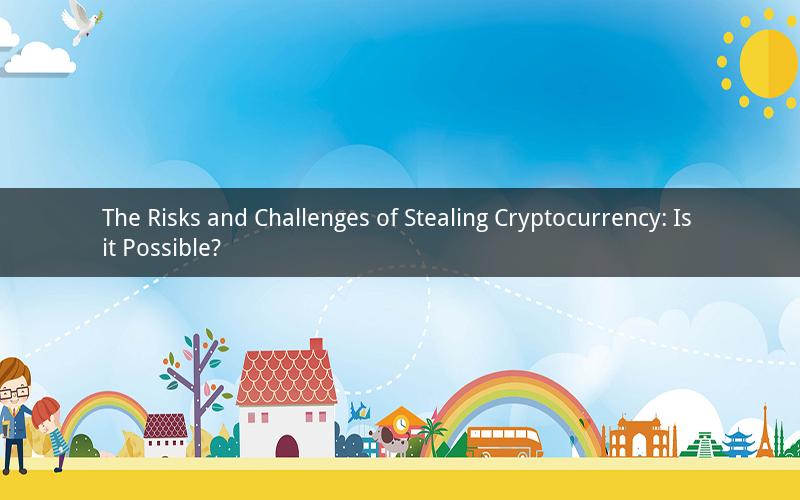
Cryptocurrency has revolutionized the financial industry by offering a decentralized and secure method of transferring value. However, with the increasing popularity of digital currencies, concerns about their security have also risen. One of the most pressing questions is whether it is possible to steal cryptocurrency. In this article, we will explore the risks and challenges associated with stealing cryptocurrency, and whether it is truly feasible.
1. The Nature of Cryptocurrency
Cryptocurrency operates on a decentralized network called blockchain, which is a distributed ledger technology. Transactions are recorded in blocks, and these blocks are added to the chain in a chronological order. The blockchain is maintained by a network of nodes, and each transaction is verified by these nodes before being added to the chain. This decentralized nature makes cryptocurrency resistant to traditional hacking methods.
2. The Challenges of Stealing Cryptocurrency
Despite the decentralized nature of cryptocurrency, it is not impossible to steal it. However, there are several challenges that make it difficult:
a. Private Keys: Cryptocurrency is controlled by private keys, which are long strings of characters. These keys are used to access and control the funds in a wallet. To steal cryptocurrency, an attacker would need to obtain the private key of the wallet.
b. Security Measures: Cryptocurrency wallets come with various security measures, such as two-factor authentication, password protection, and biometric verification. These measures make it difficult for an attacker to gain access to the wallet.
c. Cold Storage: Many cryptocurrency holders store their funds in cold storage, which is a physical storage device such as a hardware wallet. These devices are not connected to the internet, making them less susceptible to online attacks.
d. Blockchain Anonymity: While blockchain provides a certain level of anonymity, it is not entirely anonymous. Transactions can be traced back to the wallet address, which can be used to identify the owner. This makes it easier for law enforcement agencies to track down stolen funds.
3. The Risks of Stealing Cryptocurrency
If an attacker manages to steal cryptocurrency, they face several risks:
a. Legal Consequences: Stealing cryptocurrency is illegal in most countries. If caught, the attacker could face severe penalties, including fines and imprisonment.
b. Market Reputation: The cryptocurrency market is highly volatile, and the act of stealing can significantly impact the market's stability. This could lead to a loss of trust in the cryptocurrency community.
c. Countermeasures: Cryptocurrency holders and exchanges often implement countermeasures to prevent theft. This includes blacklisting stolen addresses and implementing advanced security measures to protect their assets.
4. The Feasibility of Stealing Cryptocurrency
While it is possible to steal cryptocurrency, the feasibility of doing so is low. The challenges and risks associated with stealing cryptocurrency make it a high-risk, low-reward endeavor. However, as the cryptocurrency market continues to grow, the potential rewards may attract more sophisticated attackers.
5. How to Protect Your Cryptocurrency
To protect your cryptocurrency from theft, consider the following measures:
a. Use Strong Passwords: Create strong, unique passwords for your cryptocurrency wallets and accounts.
b. Enable Two-Factor Authentication: Two-factor authentication adds an extra layer of security to your cryptocurrency accounts.
c. Store Cryptocurrency in Cold Storage: Keep your funds in cold storage to minimize the risk of online attacks.
d. Stay Informed: Keep up to date with the latest security threats and best practices in cryptocurrency security.
In conclusion, while it is possible to steal cryptocurrency, the challenges and risks associated with doing so make it a difficult and risky endeavor. As the cryptocurrency market continues to grow, it is essential to stay informed and take appropriate security measures to protect your assets.
Questions and Answers:
1. Q: Can cryptocurrency be stolen through a phishing attack?
A: Yes, cryptocurrency can be stolen through phishing attacks. Attackers may send fraudulent emails or messages to trick individuals into revealing their private keys or other sensitive information.
2. Q: How can I identify a phishing attack?
A: Look for signs of suspicious emails or messages, such as requests for personal information, misspellings, or unusual URLs. Always verify the sender's identity before providing any sensitive information.
3. Q: What is the role of blockchain in preventing cryptocurrency theft?
A: Blockchain provides a transparent and secure ledger of all transactions. This makes it difficult for attackers to alter or delete transactions, thereby reducing the risk of theft.
4. Q: Can I recover my stolen cryptocurrency?
A: Recovery of stolen cryptocurrency is possible in some cases. However, it often requires the assistance of law enforcement agencies and can be a lengthy process.
5. Q: How can I ensure the security of my cryptocurrency wallet?
A: Use strong passwords, enable two-factor authentication, and store your cryptocurrency in cold storage. Regularly update your wallet software and stay informed about the latest security threats.